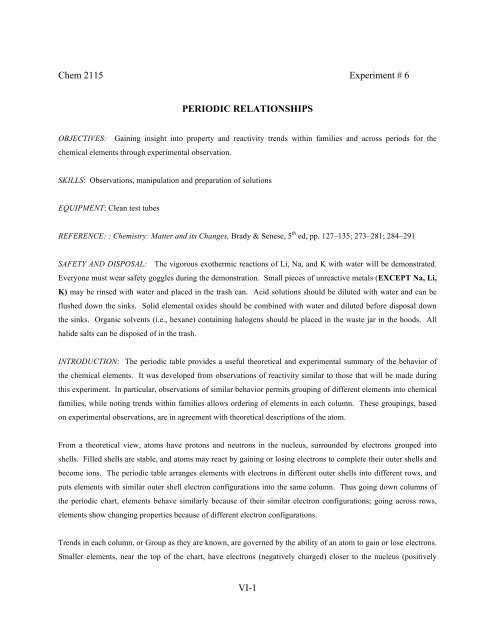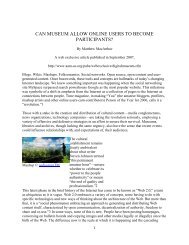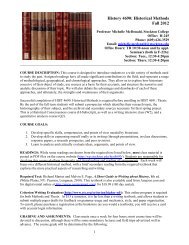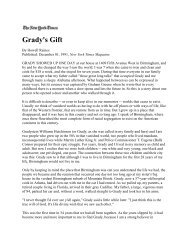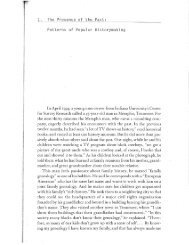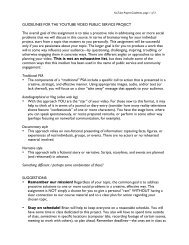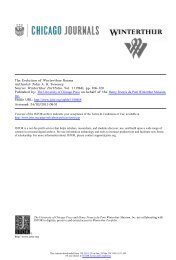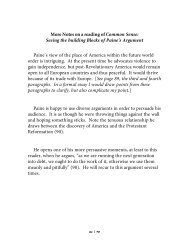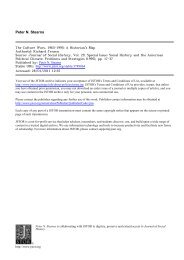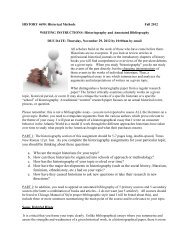VI-1 Chem 2115 Experiment # 6 PERIODIC RELATIONSHIPS
VI-1 Chem 2115 Experiment # 6 PERIODIC RELATIONSHIPS
VI-1 Chem 2115 Experiment # 6 PERIODIC RELATIONSHIPS
You also want an ePaper? Increase the reach of your titles
YUMPU automatically turns print PDFs into web optimized ePapers that Google loves.
<strong>Chem</strong> <strong>2115</strong> <strong>Experiment</strong> # 6<br />
<strong>PERIODIC</strong> <strong>RELATIONSHIPS</strong><br />
OBJECTIVES: Gaining insight into property and reactivity trends within families and across periods for the<br />
chemical elements through experimental observation.<br />
SKILLS: Observations, manipulation and preparation of solutions<br />
EQUIPMENT: Clean test tubes<br />
REFERENCE: : <strong>Chem</strong>istry: Matter and its Changes, Brady & Senese, 5 th ed, pp. 127–135; 273–281; 284–291<br />
SAFETY AND DISPOSAL: The vigorous exothermic reactions of Li, Na, and K with water will be demonstrated.<br />
Everyone must wear safety goggles during the demonstration. Small pieces of unreactive metals (EXCEPT Na, Li,<br />
K) may be rinsed with water and placed in the trash can. Acid solutions should be diluted with water and can be<br />
flushed down the sinks. Solid elemental oxides should be combined with water and diluted before disposal down<br />
the sinks. Organic solvents (i.e., hexane) containing halogens should be placed in the waste jar in the hoods. All<br />
halide salts can be disposed of in the trash.<br />
INTRODUCTION: The periodic table provides a useful theoretical and experimental summary of the behavior of<br />
the chemical elements. It was developed from observations of reactivity similar to those that will be made during<br />
this experiment. In particular, observations of similar behavior permits grouping of different elements into chemical<br />
families, while noting trends within families allows ordering of elements in each column. These groupings, based<br />
on experimental observations, are in agreement with theoretical descriptions of the atom.<br />
From a theoretical view, atoms have protons and neutrons in the nucleus, surrounded by electrons grouped into<br />
shells. Filled shells are stable, and atoms may react by gaining or losing electrons to complete their outer shells and<br />
become ions. The periodic table arranges elements with electrons in different outer shells into different rows, and<br />
puts elements with similar outer shell electron configurations into the same column. Thus going down columns of<br />
the periodic chart, elements behave similarly because of their similar electron configurations; going across rows,<br />
elements show changing properties because of different electron configurations.<br />
Trends in each column, or Group as they are known, are governed by the ability of an atom to gain or lose electrons.<br />
Smaller elements, near the top of the chart, have electrons (negatively charged) closer to the nucleus (positively<br />
<strong>VI</strong>-1
charged). Thus electrons will be attracted more strongly and in metals electrons will be lost with more difficulty<br />
than elements lower in each column. Conversely, for non-metals, which gain electrons to from ions, the elements<br />
near the top of the group will be more active since fewer electrons screen the positive nucleus. This theoretical<br />
prediction can be used to understand and explain the experimentally observed behavior.<br />
Trends in the behavior of elements in each group are governed by the preference to have a complete outer shell.<br />
Elements closer to complete shells tend to be more reactive than elements with electron configurations farther from<br />
completion. The noble gas elements, which are generally unreactive, all have complete electron shells.<br />
This experiment begins with observations of the reactivity of some metals and simple oxides (to gain insight into<br />
trends). It then focuses on the halogen family, showing the behavior of three of these elements plus their salts and<br />
solutions in water and hexane. Reactions between them are used to illustrate trends and to permit identification of<br />
unknown samples.<br />
I. Reactivity of Metals<br />
The reactivity of Na, Li, and K from Group IA, of Mg and Ca from Group IIA, and of Al from Group IIIA<br />
will be compared by observing some of their reactions with water and hydrochloric acid. From the<br />
observations, comparisons between Groups and within Groups can be made.<br />
II. Halogens<br />
The properties of chlorine (Cl2), bromine (Br2) and iodine (I2) will be observed. Chlorine is a greenish gas<br />
at room temperature and is commonly used in the laboratory. Aqueous solutions of chlorine will be used to<br />
illustrate some of the properties of chlorine. Bromine will be observed in a closed tube. Iodine will be<br />
sublimed (converted directly from the solid to the gaseous phase) and recrystallized to study its behavior.<br />
Solutions of each of these elements in water and in hexane will be examined.<br />
III. Halide Salts<br />
Halide salts are compounds formed from metals and halogen elements. The potassium halide salts will be<br />
studied by comparing their colors, solubilities, and reactivities, both alone and in combination with water,<br />
hexane, and aqueous solutions of chlorine, bromine, and iodine.<br />
Halide ions are formed when neutral halogen molecules are reduced (gain electrons from some other<br />
species, which loses them). Halide ions may lose their electrons to a more active halogen. In this<br />
experiment, chloride (Cl - ), bromide (Br - ), and iodide (I - ) ions will be combined with aqueous (water)<br />
solutions of Cl2, Br2, and I2 molecules to observe when these reactions will occur. Hexane will be added to<br />
provide evidence of reaction, since the halogen molecule which remains after reaction (or lack of reaction)<br />
<strong>VI</strong>-2
can be inferred from observing the color of the hexane layer.<br />
There is a clear trend in halogen reactivity that is related to its position on the periodic chart. This trend can<br />
be interpreted in terms of the distance between the nucleus and the outer shell electrons for each atom. The<br />
experimental observations can also be used to identify an unknown halide by comparing its behavior to that<br />
of a known sample.<br />
IV. Determination of an Unknown Halide Salt<br />
An unknown solution of either KCl, KBr, or KI in water will be assigned to each student. Students will be<br />
able to determine which of the unknown salts they have by applying the tests used in Part III D.<br />
Since the focus of this experiment is observation, be careful to write down what you see in your lab notebook as you<br />
do each step. Some of the observations in early sections will be needed to answer questions in later sections of this<br />
experiment.<br />
EXPERIMENTAL PROCEDURES<br />
BE SURE TO WEIGH YOUR CRUCIBLE AND PRODUCT FROM EXPERIMENT 5 THAT HAS DRIED<br />
OVER THE WEEK IN YOUR LOCKER. RECORD THE MASS AND ENTER THE DATA ON THE LAB<br />
COMPUTER.<br />
I. Reactivity of Metals<br />
A. (This section will be demonstrated by your instructor.) Observe freshly cut pieces of sodium, lithium<br />
and potassium. Record the physical state, color and consistency of each element. Observe the reactivity of<br />
each metal when your instructor places a small piece of each metal in separate beakers containing water<br />
and phenolphthalein. (NOTE: This is a demonstration of the reactivity of the metals with water. This is<br />
NOT an appropriate method of disposal because of the explosion potential related to the very high<br />
reactivity of these elements compared to Ca, Mg and Al.)<br />
B. Place one small piece of Ca, Mg and Al into separate test tubes. Slowly add 3-4 mL of distilled water<br />
and a drop of phenolphthalein to each test tube. Phenolphthalein will identify one of the products formed;<br />
it changes to a pink or red in the presence of a base ( OH - ) and remains colorless in an acidic ( H + )<br />
solution. Note that some reactions happen very quickly while others take much more time. If you do not<br />
observe any reaction initially, check the test tube after 15 minutes to see if a slow reaction occurred.<br />
Did any of the solutions become basic? Observe the reactivity of each metal. Which is more reactive?<br />
<strong>VI</strong>-3
C. Place a small piece of Mg and Al into separate test tubes. Carefully add 3 mL of 6 M HCl<br />
(hydrochloric acid) drop by drop. Observe the reactivity of each metal. Which is the most reactive?<br />
Notebook observations:<br />
I. Reactivity of Metals: Observations for this section should include color changes, bubbling (gas<br />
formation), temperature changes, formation/disappearance of a precipitate, and color when phenolphthalein<br />
is added.<br />
II. Halogens (Parts II A and IIB will be demonstrated by your instructor)<br />
A. Observe and describe the color and physical appearance of bromine in a closed tube when the end of the<br />
tube is immersed first in ice water and then in warm water.<br />
B. A few crystals of iodine will be placed in a small beaker and heated. The beaker will be covered with a<br />
watch glass that has some ice on it. Observe what happens to the iodine in the beaker and the formation of<br />
iodine crystals on the watch glass. The violet fumes are gaseous I2 vapor. CAUTION: Iodine is a toxic<br />
material; avoid breathing the fumes.<br />
C. Place 2 mL of aqueous solutions of Cl2, Br2, and I2 into separate test tubes. Observe the characteristic<br />
colors of each of the aqueous solutions. To each tube add 1 mL of hexane. (note which layer is the<br />
hexane layer. Is it on top or bottom?) Water and hexane are immiscible (not mutually soluble). Stopper<br />
the tube (do not use your fingers) and shake vigorously. Observe the color of each halogen in the hexane<br />
layer. Halogens are more soluble in hexane than in water, so the halogen (Cl2, Br2, or I2) will move to the<br />
hexane layer. The colors in hexane are characteristic of the halogen and can be used to identify which<br />
halogen is present in a sample.<br />
Notebook observations:<br />
IIA and B. Observations for these sections should include changes in state and colors observed.<br />
II C. Prepare a table of observations with three columns (Halogen, color of water layer, and color of<br />
hexane layer) and with rows for Cl2, Br2 and I2 Since water is denser than hexane, the aqueous layer is on<br />
the bottom of the test tube.<br />
<strong>VI</strong>-4
III. Halide Salts<br />
A. Observe the appearance of three halide salts - KCl, KBr, and KI - as solids and in solution (if any).<br />
Put a few crystals of each one into separate test tubes, add water, and shake to see if they dissolve.<br />
Put a few crystals of each one into separate test tubes, add hexane, and shake to see if they<br />
dissolve.<br />
B. Using clean test tubes, prepare the following set of nine systems:<br />
3 test tubes, each containing 2 mL of 0.1 M KCl and 1 mL of hexane.<br />
3 test tubes, each containing 2 mL of 0.1 M KBr and 1 mL of hexane.<br />
3 test tubes, each containing 2 mL of 0.1 M KI and 1 mL of hexane.<br />
To study the reactivity of the halide salts, mix each of their solutions with 1 mL of aqueous<br />
solutions of Cl2, Br2, and I2. (Put 1 mL of Cl2 solution into a test tube with KCl solution, 1 mL of<br />
Cl2 solution into a test tube with KBr, and 1 mL of Cl2 solution into a test tube with KI solution.<br />
Then do the same for Br2 and I2 solutions.) It may be helpful to construct a table similar to the<br />
one shown below to record your observations. Each box in the table represents one of your nine<br />
test tubes.<br />
Cl - Br - I -<br />
Cl2 Cl2 + Cl - Cl2 + Br - Cl2 + I -<br />
Br2 Br2 + Cl - Br2 + Br - Br2 + I -<br />
I2 I2 + Cl - I2 + Br - I2 + I -<br />
Observe the color of the hexane layer after mixing, comparing it to the results in Part IIC. If the<br />
color is the same as would be expected for the added halogen, then no reaction has occurred. If it<br />
is not, then this is evidence of a reaction.<br />
<strong>VI</strong>-5
Notebook observations:<br />
IIIA. Halide Salts: Prepare a table of observations with three columns (solid, with water, and with hexane)<br />
and with rows for KCl, KBr and KI. Your observations should include color (distinguishing the color<br />
white from “colorless”), whether or not the solid dissolves, and the color of liquids.<br />
IIIB. Halide Salt Reactions: Prepare a table of observations with three columns (for Cl2, Br2 and I2) and<br />
with rows for KCl, KBr and KI (similar to the table shown above). In each of the 9 boxes, put your<br />
observations of the colors of the (bottom) water layer and the (top) hexane layer. The hexane layer color<br />
will be crucial in determining what halogen is present after any possible reaction has taken place. (Note:<br />
Five of these systems should have I2 in the hexane layer after the halogen addition, three should have Br2<br />
and one should have Cl2. If your results do not agree with this, check with your instructor.)<br />
At this point you should be able to write the chemical reactions for samples that exhibited a reaction. For<br />
example, when chlorine (Cl2) is mixed with the iodide ion (I - ) a reaction should be observed (after shaking,<br />
the hexane layer is the characteristic color if iodine, I2). Since you began with the iodide ion (KI) and<br />
ended up with the iodine molecule (I2), this is evidence of a reaction:<br />
In many cases you will not observe any reaction (the color of the hexane layer exhibits the characteristic<br />
color of the halogen you began with). In this case, no reaction took place between the halogen and the<br />
halide.<br />
IV. Determination of an unknown halide<br />
Take one of the unknown solutions, which will contain KCl, KBr, or KI, and determine which it is by<br />
applying a test used in Part IIIB. To do this, it will be necessary to plan a procedure to distinguish between<br />
the solutions.<br />
Notebook observations:<br />
IV. Unknown halide salt determination. Write the unknown number of your salt solution. Include a<br />
clear description of the procedure you have chosen in your lab notebook. Write down your observation of<br />
the outcome of this procedure and your conclusion about the identity of your unknown.<br />
<strong>VI</strong>-6


